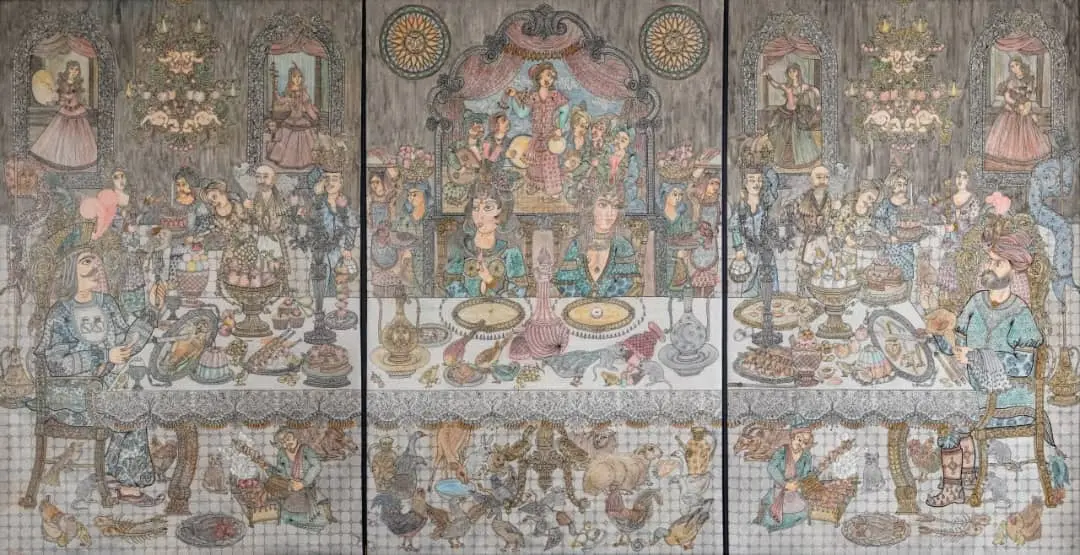
Ali Akbar Sadeghi and The Royal Feast in the Raha Gallery Collection
On the occasion of the 88th birthday of Master Ali Akbar Sadeghi, we revisit one of his magnificent triptychs, preserved today in the Raha Gallery Middle East Collection. This dazzling three-panel painting is not merely a banquet scene; it is a distilled vision of Sadeghi’s reflections on humanity, history, and social rituals. In Sadeghi’s world, celebration is always intertwined with a profound question: Is this a feast of being—or a feast of pretending? It is this very duality that elevates the work from a simple festive gathering to a visual manifesto on human nature and social performance.
ArtDayMe — The Raha Gallery Collection, founded and directed by Mohammadreza Ghaemmaghami, has, for more than two decades, maintained a sustained cultural mission focused on advancing the art of the region. It houses a diverse selection of modernist and contemporary masterpieces by Iranian and Arab artists.
Among its significant holdings is Sadeghi’s monumental triptych The Royal Feast, executed in ink, gold leaf, and silver leaf on canvas (150 × 100 cm), created in 2013. The work is published in A Survey of the Works and Life of Ali Akbar Sadeghi (pp. 156–157) by the Tehran Museum of Contemporary Art and the Ali Akbar Sadeghi Foundation.

Ali Akbar Sadeghi, born 23 November 1937, is one of the pioneers of Iran’s modern art movement and a leading figure of Surrealism in Iranian painting. He is also a distinguished illustrator of children’s books, a noted graphic designer, and a stylistically influential director in Iranian animation.
In 2008, he was honored as an Iranian Eternal Figure.
His paintings continue to attract growing attention from both the art community and the art market; yet what most distinguishes him from his contemporaries is his unbroken creativity, formal innovation, and multidimensional artistic practice—qualities that remain vibrant at 88 years old.
In the majestic and meticulously detailed triptych The Royal Feast—housed in the Raha Gallery Middle East Collection—Sadeghi brings together imagination, myth, humor, and theatre within a single banquet tableau that reaches full visual maturity.
A celebration on the surface, the scene reveals, beneath its festive veneer, a deeper narrative of humanity, power, pretense, and hidden life.
The work is quintessential Sadeghi: a world suspended between reality and fable, where everything appears to be part of a staged “performance.”
At first glance, the composition is dense with figures, foods, vessels, animals, and ornament. Yet this abundance is merely superficial.
Employing the finesse of classical Persian miniaturists, Sadeghi draws delicate, rhythmic lines across all three panels, establishing a subtle equilibrium among countless elements.
The mist-like grey background—neither night nor day, neither past nor present—gives the scene a theatrical quality, like a stage backdrop upon which characters enact their roles.
Life Flows at the Margins
In The Royal Feast, the lavish tables laden with foods, decorative sugars, Iranian dishes, and sweets display the grandeur of the gathering. Yet this splendour is only a façade for a deeper narrative:
the center of the image becomes a stage for power and pretense, while true life unfolds at the margins.
The principal sitters—formal attire, mannered postures, exaggerated features—occupy the centre with a statuesque stillness. Their gazes engage less with one another than with the social roles they embody.
By contrast, the musicians, attendants, and peripheral figures are full of movement—they embody work, energy, and the authentic flow of life.
This tension between centre and margin is one of Sadeghi’s fundamental narrative structures.

Nature Is Free; Humans Are Bound by Their Roles
Across the lower register of each panel, small domestic animals—hens, goats, rabbits, birds—move freely.
They stand in stark contrast to the heavy, ceremonial stillness above the table.
Their warmer, simpler palette, set against the chromatic complexity of the human figures, conveys a clear meaning: Nature is free; humans are confined by their roles.
These animals are not mere decorative margins—they represent “life” itself, unburdened by performance.
Large eyes, elongated brows, suspended half-smiles, and slightly mechanical limbs form part of Sadeghi’s visual humour.
Characters in this feast are more “roles” than individuals—actors caught in a ritual theatre.
Through exaggeration, Sadeghi shows that, in his world, humanity is always performing.
Muted Greys and Antiqued Gold: A Subtle Critique of Splendour
The chromatic foundation of the triptych rests on muted greys and cool blues. This tonal structure:
• turns the scene into a timeless, theatrical environment,
• draws attention from background to figures, and
• constructs the semi-mythical, suspended atmosphere characteristic of Sadeghi.
Turquoise and aquamarine tones in garments, curtains, and vessels recall Iranian tilework, reinforcing cultural identity and providing rhythmic continuity across the triptych.
Warm but unsaturated hues—dusty pinks, earthy reds, muted peaches—animate faces and foods, intensifying the emotional pulse of the feast and adding narrative warmth against the cool background.
Gold, however, does not shine here; it is aged, dusted, subdued.
Through this choice, Sadeghi represents opulence yet subtly mocks its radiance:
tarnished gold becomes the emblem of a splendour that dazzles but lacks depth.
In the lower zone, the animals are rendered in natural browns and yellows—warm, simple, alive.

This warmth intentionally contrasts with the coldness above:
the realm of performance is cold; the realm of life is warm.
In Sadeghi’s world, every celebration carries a universal question.
Is this a feast of being—or a feast of pretending?
It is this dual structure that transforms the artwork into a visual drama about humanity and its social theatre.
Within this world:
• the centre is the stage of power and performance,
• the margin is the site of life and movement,
• cool tones construct the theatrical space,
• warm tones shape the emotional rhythm, and
• animals stand as reminders of life’s unornamented truth.
Like a pictorial play, the triptych asks the viewer:
Is this a feast of being—or a feast of pretending?
This artwork belongs to the Raha Gallery Middle East Collection.

LEAVE A RELPY